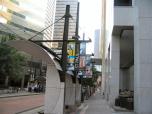




…for the temple is not for man but for the LORD God….
How was the temple representative as a work of religious art?
First, the structure and majesty of the building itself was a testimony to all of Israel, and to the surrounding nations of that era of God’s overwhelming power and authority. (For purposes of this article we will only describe the structure. Later articles will detail furnishings and decorations.)
The structure was large and commanding, even though it was not necessarily huge by today’s standards. The Most Holy Place was approximately 33 feet in length, width, and height. On the wall of the Most Holy Place were two cherubim which were each made from olive wood. They stood 16 ½ feet high and each one had a wing outspread of 16 ½ feet. The wings touched the edge of the wall on the outside and each other on the inside.
The Holy Place was double in size to the Most Holy Place or 66 feet in length, width and height. The Porch that was attached on the eastern side was 33 feet in length and 16 ½ feet in depth. Two pillars were on it, both of which were 30 feet high and 6 feet wide. Chambers built on the southern, western, and northern sides of the temple were originally one story, with two additional stories possibly added later.
There were two courts which surrounded the temple, including the Great Court where people assembled to worship. A brazen altar stood before the temple and had dimensions that were 33 feet squared and 16 ½ feet in height.
The brazen sea measured 16 ½ feet in width from brim to brim, 8 feet in depth, and had a circumference of 50 around the brim. It rested on the backs of twelve oxen. The Old Testament book of I Kings gives its capacity as being 2,000 baths or 90 cubic meters, whereas II Chronicles provides a figure of 3,000 baths or 136 cubic meters
The opening line of the melody of Psalm 80 verse 1compares the law as testimony to a choice flower.
Second, what the temple represented to Israel and the nations around it was a testimony to the power and greatness of God. When we consider the word testimony, some definitions include: a solemn statement made under oath, an assertion offering firsthand authentication of a fact, something that serves as evidence; "his effort was testimony to his devotion", Testimony is what is deposed to by a witness on oath or affirmation. When used figuratively or in a wider sense, the word testimony has still a reference to some living agent as its author, as when we speak of the testimony of conscience, or of doing a thing in testimony of our affection, etc. Testimony refers rather to the thing declared, evidence to its value or effect. "To conform our language more to common use, we ought to divide arguments into demonstrations, proofs, and probabilities; by proofs, meaning such arguments from experience as leave no room for doubt or opposition."
Give ear, O Shepherd of Israel, thou that leadest Joseph like a flock, thou that dwellest between the cherubims, shine forth.
Third, God’s overwhelming power and authority is displayed here. Several verses testify to that. Exodus 20 verse 2 states “I am the LORD your God, who brought you out of the land of Egypt, out of the house of slavery. The Israelites were in a helpless position in making bricks for the Egyptians. They could not have delivered themselves. God by His authority caused the knee of the Egyptians to eventually bow. In Exodus 3 verse 6, God said to Moses, ”I am the God of your father, the God of Abraham, the God of Isaac, and the God of Jacob. God had staying power. He has existed for eternity and will exist for eternity. Men and women live for seventy, eighty or one hundred years, but eventually their earthly bodies die. They cannot trump the staying power of God. This temple in many ways represented the authority of God by the magnificence of its structure.
One thing I have asked from the LORD, that I shall seek: that I may dwell in the house of the LORD all the days of my life, to behold the beauty of the LORD and to meditate in His temple.
Temple Fruit Diaries - The Temple as a work of Religious Art
Posted: May 7, 2012 by Chuck DeShazo
